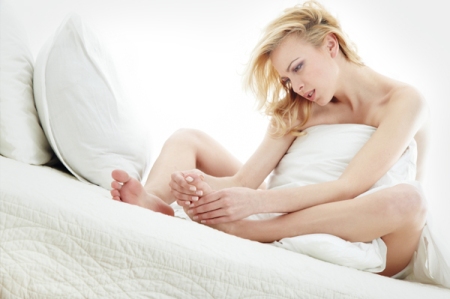
Woman with foot pain (source: Sheknows.com)
Foot pain comes in many shapes and sizes. There are literally hundred`s of possible causes of the foot pain, so we can`t even hope to cover all of them. We will, however, make an attempt to cover some of the most common foot conditions that are known to cause pain and discomfort.
Most Common Foot Pain Causes And Symptoms
As we already mentioned, there are numerous causes of pain and foot injuries, but we can categorize them into few groups:
- Trauma – certainly one of the most common causes of pain – not just in the foot. The trauma doesn`t even have to be intense or severe, repetitive motion can cause microtraumas to the bones of the foot (known as microfractures) and lead to painful conditions. Dropping a heavy load onto your foot is also a common type or trauma.
- Health conditions – various health conditions can be the cause of pain in the foot. We will be covering some of these conditions in this article.
And the most common symptoms are:
- Pain
- Stiffness in the muscles and joints of the foot
- Tightness and, in some cases, limited range of motion
Foot Conditions
Broken Toes
This condition is one of the most common causes of foot pain among all ages and genders. Stubbing is the common way people break it, by running into a piece of furniture at night.
It is also important to note that, even though the toe will hurt like hell (specially if you stub your little toe), not all injuries will cause the cone to break. Our bones are quite strong and a great deal of force is required to be able to break it.
So, you might want to wait for a couple days, and if the pain starts to intensify, then you should definitely visit your doctor.
Hammer Toe
Stop! Hammer time! Well, not really…
Hammer toe usually starts out as a mild deformity, and then progresses over time. In the beginning the toes are flexible and symptoms can often be quite manageable. But, if left untreated, toes will become rigid and won`t respond to anything but surgical treatment.
Luckily, the toes will respond to early therapy well; there are also a wide range of gel pads you can use to relieve the pain and symptoms of hammer toes.
Overlapping Toes
Overlapping toes are relatively common in older age and can affect any of the toes. This is also a problem which could be corrected if acted in a timely manner. Patients who change shoes (get shoes with bigger toe boxes) or use gel toe straighteners can prevent and treat this condition.
However, if the condition is not treated in time, irritation can turn into degeneration of joints in the toes that could vary in its severity.
 When talking about health, we usually refer to physical health; what we often forget is that mental health is equally (if not more) important aspect of health! And only if your mental health is satisfactory, will you be able to feel good physically.
When talking about health, we usually refer to physical health; what we often forget is that mental health is equally (if not more) important aspect of health! And only if your mental health is satisfactory, will you be able to feel good physically.

